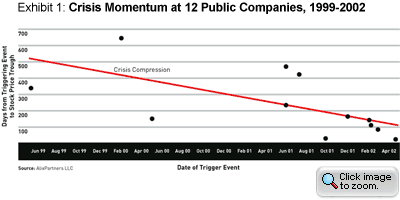Learning Success from Distress
Because the line between underperformance and crisis is thin, a CEO needs to think like a turnaround artist.
 |
|
Illustration by Lars Leetaru |
Halfway across the country, over an elegant dinner, another CEO congratulates her team on a tremendous acquisition that will please the Street, generate tremendous revenue growth, and ensure her annual bonus. But in her heart she knows she and her team are starting a hard slog in which they will examine every part of the new acquisition to squeeze out incremental cash, to improve sales and service performance, to rebuild employee morale, and more. She knows that there is a thin line between success and failure and that she has only one chance to get this right.
The best CEOs are smart enough to realize that things can get worse and that continuous improvement isn’t a catchphrase — it’s a mentality. That means successful company leaders always have a little bit of the turnaround artist in them. They look for trouble. They are never satisfied with the status quo. They know perfection does not exist. They push for improvement to combat inertia and for transformation to fight competition.
We are a firm of hands-on restructuring and performance-improvement professionals who have guided hundreds of turnarounds and significant improvement programs over 22 years, in industries as different as transportation (Ryder System Inc. and National Car Rental), telecommunications (Unisys), and retailing (the Kmart Corporation). Although it is true that, like every unhappy family, every distressed company is unique, we have found a set of near-inviolable truths that characterize all companies teetering into trouble. Here are five “lessons from distress” that are applicable to any company — the healthy, the underperforming, and the crisis-bound.
Lesson #1: It’s the cash. We have a saying at our firm: “If you’re out of cash and out of credit, you’re out of business.” It seems obvious, but we are continually surprised at how often senior executives and directors are completely unaware of their company’s liquidity position — even if other indicators are pointing to trouble.
A medical device company whose share price had started to plummet engaged our company to collectively serve as interim CEO to stabilize finances, adjust the company’s operating portfolio, and provide a transition from a charismatic leader to a new leadership team. The board assured us the company was healthy, with plenty of liquidity. Instead, the first week we were there, we found the company barely able to make payroll. And the company’s longtime lender had withdrawn a line of credit that might have kept the business afloat.
This story is not unusual. The 1990s saw an unprecedented increase in leverage, as the booming economy encouraged credit risk that in retrospect we know to have been excessive. To avoid such situations, a wise board and skilled management team should have several cash management tools:
- A 13-week detailed cash flow forecast that is based not on profit-and-loss projections, but on projections of actual receipts and disbursements. This is not something most accounting systems routinely supply, so it requires a change in mind-set as well.
- A longer-term cash forecast that is based on the P&L and changes in working capital but that also shows major debt and capital expenditure.
Of course, more important than having the tools is using them. In the medical device company’s case, neither the board nor management had been monitoring the cash closely enough to see the problem coming.
Lesson #2: The numbers may not be giving you adequate warning of a looming cash crisis. At the medical device supplier, the board’s misplaced sense of security was based partly on a cursory misreading of the financial statements. A look at the accounts receivable line told them there was plenty of near-term cash coming in. After we arrived, it took only a couple of hours to realize that most of the receivables were more than 90 days overdue and were unlikely to be collected.
It’s not just receivables that can mislead. Inventory, payables, and other P&L items are subject to enough GAAP interpretation that the consolidated financial statements of many companies do not reflect the real financial condition.
There are many nonfinancial variables that should be watched as well. When Henry Singleton and George Kozmetsky founded Teledyne, which in its day became the fastest company ever to reach $1 billion in sales, they realized that the financial statements were not only somewhat artificial but also too slow to be useful. They decided that the best way to understand the health of their business was to monitor the daily quality control reports. They knew that Teledyne, as a manufacturing company, would be judged by its customers on the quality of its products; thus, the best place to examine the company’s true health was right at the end of the production line.
The important point is that directors and management need to monitor the business in as many ways as is practical, without, obviously, overburdening the company with useless “questions for questions’ sake.” What are customers thinking? How full is the prospective sales pipeline? Is delivery performance improving? How is employee morale? What is the market saying about us? We have seen many companies in which these leading indicators would have pointed to trouble long before the financials spelled distress — if only someone had looked at them.
Lesson #3: If it ain’t broken, it’s broken. The best-performing companies have gone beyond continuous improvement as a theme or an initiative and made it a mind-set, part of the organization’s culture. Even if the company seems to be firing on all cylinders, there’s always a process that can be improved or a location that needs to be turned around or a customer relationship that needs to be repaired.
Rollups, a major corporate strategy in many industries during the 1990s, frequently illustrate this principle. Many rollups have become crisis clients of ours; we think it is because the team that is good at acquisitions is often not good at integrating those acquisitions into a single business with a coherent operating model. (See “Strategic Rollups: Overhauling the Multi-Merger Machine,” by Paul F. Kocourek, Steven Y. Chung, and Matthew G. McKenna, s+b, Second Quarter 2000.)
At one rollup with which we were involved, a medical-practice management business, we arrived to find that there was no systematic effort under way to improve the poorer practices that had been acquired during the buying spree. Instead, the acquisition-minded team viewed the underperforming practices as candidates for divestiture, even at prices below what they had paid. We helped implement a turnaround process that sent teams to the worst performers to work on provider utilization, patient scheduling, back-office improvement, and implementation of patient treatment plans. The results were dramatic and kept the new management from selling valuable assets for less than the acquisition price.
The tricky part was to establish the mentality that there is always a “tail end of the curve” — units, functional departments, or regions that would benefit from a turnaround approach. We are not suggesting that companies put themselves in a crisis mode at all times. At many companies, that would be destabilizing; at most, the attitude would yield diminishing returns, as staff grow inured to the frenzy. Instead, we are recommending that companies always put pieces of the business in turnaround. That not only builds an organizational capability for doing turnarounds, but also sends the message to the organization that you are serious about continuous improvement.
Lesson #4: There’s no such thing as “too fast.” The earlier you start and the faster you move, the more degrees of freedom you have to fix a business. Wait, and your options fade and control slips away.
This follows on the principles enumerated above. If you wait until a crisis manifests itself, your room to maneuver will be very limited. Putting a division or location or process into turnaround at the first sign of trouble can give management many months to avert a crisis. Leadership will have time to rethink strategy, to make major changes to the business model, to implement new information technology, and the like. If you are running out of cash in 18 weeks, the only levers you have available are quick-and-dirty cost cutting and asset fire sales.
The need for speed is evidenced in the bankruptcy boom. Public company bankruptcy filings have been at historic highs, with 179 in 2000, 257 during 2001, 189 during 2002, and an estimated 160 for 2003. There has been an acceleration of the crisis cycle, as well, for many companies. In other words, firms are going from peak to trough much faster than before.
Exhibit 1 illustrates this principle. Using 12 of the most significant companies that fell into trouble between June 1999 and April 2002, it depicts the increasingly rapid “crisis momentum” in public companies by plotting the number of days between a triggering event — a public announcement of an earnings decline, an accounting investigation, a fraud allegation, or the like — and a stock-price trough. As the least-squares line shows, the time plummeted from more than 200 days in 2000 to 100 days or fewer in 2002. Shareholder tolerance is very low for companies that allow themselves to fall into a visible crisis, and that tolerance is not likely to improve.
True, the “move fast” mentality means that action will be commenced before all the analysis can be done. But our experience is that the “80/20 rule of management” really does work. Decisive leaders making good intuitive decisions informed by 80 percent of the data and analysis will always outperform those who insist on more and more analysis until the moment for action passes.
Lesson #5: Fix the business, not the financials. If you are a senior manager or director and you’re not spending most of your time on the business itself, you must ask yourself why. We have seen a disturbing pattern in some recent crises we’ve been called in to remedy:
- A company with terrific performance generates tremendous share price gains.
- Operating performance starts to slip for a combination of external and internal reasons.
- Desperate to keep the stock price up, the management team, with board acquiescence, turns to financial engineering rather than business issue repair.
- The mask of financial manipulation is eventually removed to reveal the operating problems underneath.
In one example, a company we know reported a healthy 13 percent gain in EBITDA from 2000 to 2001. However, management got it there by capitalizing operating expenses and engaging in swap transactions to enhance revenue. In so doing, they disguised the troubles at the heart of the business, and when their actions caught up with them, the business fell hard.
We suggest a better solution and a more enlightened approach to governance for the board and management: Maintain a laser focus on the operations of the business, rather than the stock price and consolidated GAAP-based financials. Cash is king even in healthy companies, because there is nothing more fundamental than cash.
The distance between healthy and underperforming companies can be as thin as a dime. Every business has operating weaknesses. Companies are not machines with fixed inputs and outputs. Companies are adaptive organizations closer to biological cells thriving in more or less hostile environments.
Any number of subtle events can retard growth or present opportunity for expansion. Companies underperform when negative human performance and negative operating events combine with negative economic events to affect revenues, costs, and liquidity — and when management fails to mitigate the harm. Companies move — increasingly quickly these days — from health to sickness to death. There are opportunities during the process to stop the deterioration, but frequently they require radical change.
The difficulty is that most people fear and avoid change, even positive change. They don’t like it because it is not comfortable. Yet it is always better to address weaknesses early because losses grow exponentially as problems grow, working capital is depleted, and alternative solutions available to a CEO diminish.![]()
Reprint No. 03401
Jay Alix (jalix@alixpartners.com) is the founder of AlixPartners LLC, a leading turnaround, performance improvement, and financial advisory firm in Southfield, Mich.
Jay Marshall (jmarshall@alixpartners.com), a former vice president at Booz Allen Hamilton, is a principal with AlixPartners. Based in Dallas, he co-leads its performance improvement practice.





